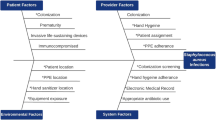Abstract
Objective:
Nosocomial infections (NI) are a frequent and important cause of morbidity and mortality in newborn infants who receive intensive care. We sought to determine if comprehensive infection control (CIC) measures decrease rates in a large neonatal intensive care nursery.
Methods:
Single center interventional study. The CIC intervention consisted of increasing nursing and physician education and awareness of infection rates, establishing common improvement goals, training in hand and environment care, and implementing a specialty nursing team for central venous and arterial catheter care. Demographic and microbiology information for all infants admitted to the NICU from January 1, 1999 to December 31, 2000 established baseline data. The intervention period was during January and February 2001. The postintervention period was March 1, 2001 to February 29, 2004. The main outcome measure was the rate of blood, cerebrospinal and/or urinary tract bacterial infections per 1000 hospital days.
Results:
Baseline infection rate was 8.5 per 1000 hospital days. The NI rate fell 26% (P=0.002) from baseline in the first year and 29% (P<0.001) in the second and third years after the CIC intervention. The reduction in total NI was due mostly to a 46% fall in coagulase-negative Staphylococcus infection rate (P<0.001); however, rates of all other organisms also fell by 21% (P=0.05).
Conclusions:
CIC measures can reduce bacterial and fungal NI rates. This effect has been sustained for 3 years following the intervention.
This is a preview of subscription content, access via your institution
Access options
Subscribe to this journal
Receive 12 print issues and online access
$259.00 per year
only $21.58 per issue
Buy this article
- Purchase on Springer Link
- Instant access to full article PDF
Prices may be subject to local taxes which are calculated during checkout

Similar content being viewed by others
References
Lemons JA, Bauer CR, Oh W, Korones SB, Papile LA, Stoll BJ et al. Very low birth weight outcomes of the National Institute of Child health and human development neonatal research network, January 1995 through December 1996. NICHD Neonatal Research Network. Pediatrics 2001; 107: E1.
Stoll BJ, Hansen N, Fanaroff AA, Wright LL, Carlo WA, Ehrenkranz RA et al. Late-onset sepsis in very low birth weight neonates: the experience of the NICHD Neonatal Research Network. Pediatrics 2002; 110: 285–291.
National Nosocomial Infections Surveillance (NNIS). System Report, data summary from January 1992 through June 2003, issued August 2003. Am J Infect Control 2003; 31: 481–498.
Horbar JD, Rogowski J, Plsek PE, Delmore P, Edwards WH, Hocker J et al. Collaborative quality improvement for neonatal intensive care. NIC/Q Project Investigators of the Vermont Oxford Network. Pediatrics 2001; 107: 14–22.
Kilbride HW, Wirtschafter DD, Powers RJ, Sheehan MB . Implementation of evidence-based potentially better practices to decrease nosocomial infections. Pediatrics 2003; 111: e519–e533.
Sharek PJ, Benitz WE, Abel NJ, Freeburn MJ, Mayer ML, Bergman DA et al. Effect of an evidence-based hand washing policy on hand washing rates and false-positive coagulase negative staphylococcus blood and cerebrospinal fluid culture rates in a level III NICU. J Perinatol 2002; 22: 137–143.
Jarvis WR . Controlling healthcare-associated infections: the role of infection control and antimicrobial use practices. Semin Pediatr Infect Dis 2004; 15: 30–40.
Tan ND, Davidson D . Comparative differences and combined effects of interleukin-8, leukotriene B4, and platelet-activating factor on neutrophil chemotaxis of the newborn. Pediatr Res 1995; 38: 11–16.
Christensen RD, Brown MS, Hall DC, Lassiter HA, Hill HR . Effect on neutrophil kinetics and serum opsonic capacity of intravenous administration of immune globulin to neonates with clinical signs of early-onset sepsis. J Pediatr 1991; 118: 606–614.
Redd H, Christensen RD, Fischer GW . Circulating and storage neutrophils in septic neonatal rats treated with immune globulin. J Infect Dis 1988; 157: 705–712.
Landor M . Maternal-fetal transfer of immunoglobulins. Ann Allergy Asthma Immunol 1995; 74: 279–283.
Gastmeier P, Groneberg K, Weist K, Ruden H . A cluster of nosocomial Klebsiella pneumoniae bloodstream infections in a neonatal intensive care department: identification of transmission and intervention. Am J Infect Control 2003; 31: 424–430.
Clark R, Powers R, White R, Bloom B, Sanchez P, Benjamin Jr DK et al. Prevention and treatment of nosocomial sepsis in the NICU. J Perinatol 2004; 24: 446–453.
Ganeswire R, Thong KL, Puthucheary SD . Nosocomial outbreak of Enterobacter gergoviae bacteraemia in a neonatal intensive care unit. J Hosp Infect 2003; 53: 292–296.
Zafar AB, Sylvester LK, Beidas SO . Pseudomonas aeruginosa infections in a neonatal intensive care unit. Am J Infect Control 2002; 30: 425–429.
Hitomi S, Kubota M, Mori N, Baba S, Yano H, Okuzumi K et al. Control of a methicillin-resistant Staphylococcus aureus outbreak in a neonatal intensive care unit by unselective use of nasal mupirocin ointment. J Hosp Infect 2000; 46: 123–129.
Hylander MA, Strobino DM, Dhanireddy R . Human milk feedings and infection among very low birth weight infants. Pediatrics 1998; 102: E38.
Schanler RJ, Lau C, Hurst NM, Smith EO . Randomized trial of donor human milk versus preterm formula as substitutes for mothers’ own milk in the feeding of extremely premature infants. Pediatrics 2005; 116: 400–406.
Acknowledgements
Dr Schelonka received support from the National Institute of Child Health and Human Development, HD043327.
Author information
Authors and Affiliations
Corresponding author
Rights and permissions
About this article
Cite this article
Schelonka, R., Scruggs, S., Nichols, K. et al. Sustained reductions in neonatal nosocomial infection rates following a comprehensive infection control intervention. J Perinatol 26, 176–179 (2006). https://doi.org/10.1038/sj.jp.7211411
Received:
Revised:
Accepted:
Published:
Issue Date:
DOI: https://doi.org/10.1038/sj.jp.7211411
Keywords
This article is cited by
-
Nosokomiale Infektionen in der Neonatologie
ProCare (2009)



